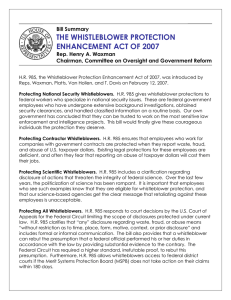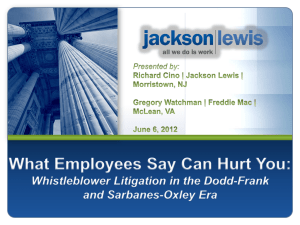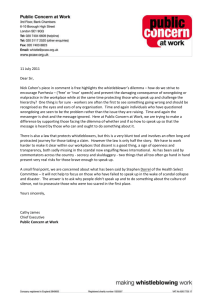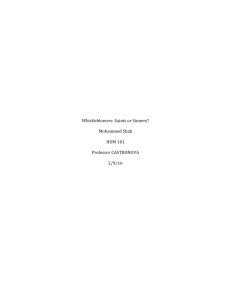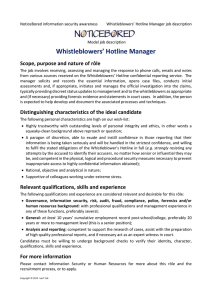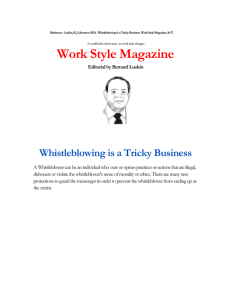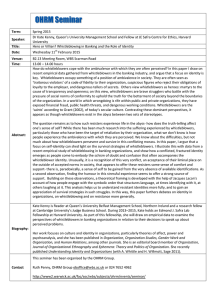Andrew Wilkie and the difficult task of the
advertisement
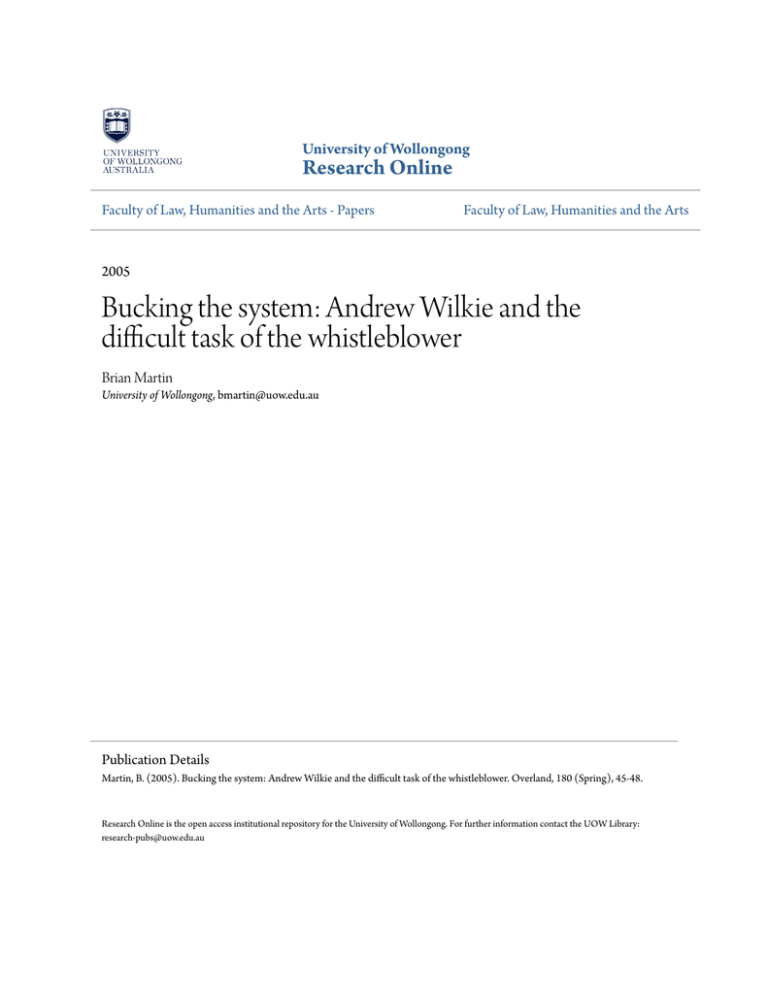
University of Wollongong Research Online Faculty of Law, Humanities and the Arts - Papers Faculty of Law, Humanities and the Arts 2005 Bucking the system: Andrew Wilkie and the difficult task of the whistleblower Brian Martin University of Wollongong, bmartin@uow.edu.au Publication Details Martin, B. (2005). Bucking the system: Andrew Wilkie and the difficult task of the whistleblower. Overland, 180 (Spring), 45-48. Research Online is the open access institutional repository for the University of Wollongong. For further information contact the UOW Library: research-pubs@uow.edu.au Bucking the system: Andrew Wilkie and the difficult task of the whistleblower Abstract WHISTLEBLOWERS ARE PART of society's alarm and self·repair system, bringing attention to problems before they become fur more damaging.l Australian whistlcblowers have spoken du[ abollt police corrupcion, paedophilia in the churches, corporate mismanagement, biased appointment procedures, environmentally harmful practices and a host of other issues. Although whistleblowers are extremely valuable to society, most of them suffer enormously for their efforts. Ostracism, harassment, slander, reprimands, referral to psychiatrists, demotion, dismissal and blacklisting are among the common methods used to attack whistleblowers. Bosses are the usual attackers with co-workers sometimes joining in. Disciplines Arts and Humanities | Law Publication Details Martin, B. (2005). Bucking the system: Andrew Wilkie and the difficult task of the whistleblower. Overland, 180 (Spring), 45-48. This journal article is available at Research Online: http://ro.uow.edu.au/lhapapers/1092 ~/I I I I I I I I I I I 1IIIfllllll/llllll 200510881 pllblic policy fllllll I BRIAN MARTIN BUCKING THE SYSTEM ANDREW WILKIE AND THE DIFFICULT TASK OF THE WHISTLEBLOWER WHISTLEBLOWERS ARE PART of society's alarm and self· repair system, bringing attention to problems before they become fur more damaging. l Australian whistlcblowers have spoken du[ abollt police corrupcion, paedophilia in the churches, corporate mismanagement, biased appointment procedures, environmentally harmful practices and a host of other issues. Although whistleblowers are extremely valuable to society, most of them 5utler enormously for their efforts. Ostracism, harassment, slander, reprimands, referral to psychiatrists, demotion, dismissal and blacklisting arc among the common methods used to attack whistleblowers. Bosses are the usual attackers with co-workers sometimes joining in. Many whisdeblowers are conscientious, highperforming employees who believe that the system works. That's why they speak out. They believe that by alerting others to a problem, it will be dealt with. Many do not think of themselves as whistle blowers , at all - they believe they arc just doing their job. So they are shaken to the core when the response to their public-spirited enons is to vilify them as disloyal, to question their work performance, to withdraw emotional support and to mount attacks. As well as suffering financial losses and severe stress, whistleblowers are at increased risk of relationship breakdown and health problems. Even worse than this, though, few whistleblowers seem to bring about any change in the problem they speak out about. The treatment of whistleblowers is a double disaster for society: capable and courageous indi\riduals arc attacked and sometimes destroyed, while the original problems arc left to tester. Bill Toomer W'1S \Vestern Australia's senior quarantine inspector in 1973 when he requested fi.lmigation of a ship in Fremantle because of the presence of mice and rats. Fumigation is costly and time-consuming and hence disliked by shipowners. Previously, in Victoria, Toomer had rdllsed bribes to ignore intestations ofships. [n the Fremantle case, Toomer was overruled by his superior and bdore long was fined, demoted and transferred. [n 1980, due to the pressure, he retired at age 45. [n the past three decades, his case has been brought before numerous politicians and 'lgencies, including the Ombudsman, the Administrative Appeals Tribunal and the Merit Protection and Review Agency, with a number of them holding formal inquiries. Even today, Toomer's supporters continue to petition the government tor compensation and have gathered evidence that Toomer was set up in Fremantle tor removal from ship quarantine duties. 2 For onc man to lose his career is bad enough. For millions of dollars to be spent on inquiries is an added burden. But in some ways worst of all is that focusing on the treatment ofToomer distracted attention from the original issue of corruption in quarantine inspections. Mick Skrijel was a craytisherman in South Australia in 1978 when he reponed to police and politicians what he thought were drug drops off the coast. Afterwards, his catches were stolen, his boat was destroyed by fire, his house was partially burnt and he was bashed. Moving to Victoria in the 19805, his allegations were passed to the newly crcated National Crime Authority. Skrijelleaflt:tcd and picketed NCA headquarters over its inaction - and then the NCA investigated Skrijel himselt~ who went to prison for five months after a raid found explosives and marijuana on his property. His convicrion was later quashed by the Victorian Slipreme Court: the OVERLAND 18012005 45 Copyright of Full Text rests with the original copyright owner and, except as permitted under the Copyright Act 1968, copying this copyright material is prohibited without the permission of the owner 6r--~ its exclusive licensee or agent or by way of a licence from Copyright Agency Limited. For information about such licences contact Copyright Agency Limited on (02) 93947600 (ph) or (02) 93947601 (fax) assun~ptions of ethnic superiority, had little salience outside Illdonesia. Thc third method is to reinterpret the events. Illdol1esi.Ul officials blamcd the events on the pro· tcsters, alleging they provoked the attack and that the shooting was unintentional. They gave a figure of just nineteen dcad, later raising it to fifty. A separate investigation counted at least 271 killed. The tourth method of inhibiting outrage is to use official channels such as inquiries and courts to give the appearance ofjustice. Immediately after the Dili massacrc, the Indonesian government set lip an inquiry, which gave mild sentences to a tcw officials. The Indonesian military had its own inquiry that whitewashed the perpetrators. The fit1:h and final method regularly used to in· DISSIPATING OUTRAGE hibit outrage from injustice is intimidation and brib· To develop better tactics tor whistleblowers, it is cry of targets, witnesses and functionaries. After the useful to examine injustices that cause outrage. shooting, Indonesian troops arrested, beat and killed Consider, tor example, the Dili massacre.~ On 12 numerous East Timorese independence supporters. November 1991, thousands ofEast Timorese joined This may have intimidated some East Timorese but a funeral procession in DiU, using the occasion to it had little dfect on international audiences. protest against the Indonesian occupation of the By looking at methods of inhibiting outrage, it country. As the crowd entered Santa Cruz cemetery, is possible to gain insight into how to promote out· Indonesian troops that had surrounded the marchers rage. Cover·up can be countered by methods such as collecting documents, writing stories and using opened fire without warning. Unlike earlier massacres, this atrocity was wit· alternative media. Devaluation can be countered nessed by Western journalists and captured on video- by humanising people under attack, tor example tape by filmmaker Max Stahl. Their reports led to through meetings and personal stories. Reinter· international outrage against the Indonesian occupi- pretation can be countered by presenting the taers ers and a massive boost for the international support and emphasising the injustice involved. The false movement for East Timorese independence. The appe'1rance of justice though official channels can be brutal assault on the funeral procession, intended to countered by avoiding or discrediting these chan· intimidate and subdue the independence , movement, nds. Intimidation and bribery can be countered by instead had the opposite effect of greatly increasing renlsing to acquiesce and by exposing these methods support for it. In short, the attack backfired on the as improper. Indonesian government. Whistlebl.owing usually involves a double injus· In attacks like this, there are five methods com· tice. First is the problem - corruption, abuse, a hazmonly llsed by attackers to inhibit olltrage. The first is ard to the public - about which.1 person speaks out. cover·up. In previous massacres in East Timor, censor· Second is the treatment of the whistleblower. Both ship had prevented information getting out in a timely of these have the potential to backfire, if people rec· and authoritative tashion. After the Dili massacre, the ogllise them as matters tor concern and intormation Indonesians cut otfphone services out of East Timor. about them is communicated to receptive audiences. They also alerted Australian customs to search lvbx Thadore it is predictable that perpetrators will use Stahl, but he wisely gave his videotapes to someone these five methods of inhibiting outrage. That is exactly wh~lt can be observed in case after case. else who smuggled them out of East Timor. The second method of inhibiting outrage is to devalue the target. Indonesian officials madc deroga· WHAT HAPPENS TO WHISTLEBLOWERS tory comments about the protesters, tor example Those.: who .1ttack whisrleblowers usually like to keep calling them "scum", but this abuse, and Javanese things quiet. Only foolish cmplo}'crs al1l10uIlce to judges t(JUnd the explosives and marijuana could have been planted. Investigating the matter at the request of the government, QC David Quick recom· mended an inquiry, with royal commission powers, into the possibility that Skrijd was framed, but the government dedined. 3 Vast efforts have been made by Skrijcl and his sup· porters topursue justice over his case. Somewhere along the line, the original issue ofthe South Austral· ian drug trade dropped off the main agenda. These are but sketches of cases that are incredibly complicated, as are most whistleblower stories. But after he;'lring hundreds of such stories, there is ;'I burning question that is easy to articulate: How can whistleblowcrs do better? 46 0 V E R LA N 0 180 I 2005 the world that they have sacked a prominent dissident. vVhcn whistlcblowt:rs go to court, employers often agree to a settlement under the condition that neither party speaks about the settkmcnt itself Acceptance of such a so-called gagging or silencing clause is often ,1 precondition for a settlement. Whistleblowers often want to keep things quiet too. Many of them<jre embarrassed and humiliated by the allegations against them and do not want others to be aware of their difficulties. Often they are making complaints to official bodies and assume that publicity will hurt tht:ir case. In many cases, lawyers advise keeping quiet. The upshot is that whistleblow· el's commonly cooperate with employers in covering up intormation about what is happening. The same applies to the original problem about which they spoke up. The result is th,lt outrage is minimised. The second method of inhibiting olltrage is to devalue the target, in this case the whistleblower. This is part of the standard treatment: harassment, referral to psychiatrists, reprimands and the like are potent means of discrediting a person in the eyes of fellow workers. Spreading of rumours is part of the package, including malicious comments about the whistle blower's work performance, personal behaviour and mental state. To counter this, whistleblowers need to behave impeccably - a difficult task when under intense scrutiny and immense stress - and to document their good performance and behaviour. This can be done, but only if the whistle blower is able and willing to muster the information and make it available. Reinterpretation of the events is the third method of inhibiting outrage. Employers typically deny , any wrongdoing and say that treatment of the employee is completely justified ;,llld nothing to do with public interest disclosures. Whistkblowers need to challenge the official line by providing solid documentation tor everyone of their claims. The fourth method is to use official channels that give only the appearancc of justice. An employer might dismiss an employee and then, when the employee challenges the decision, put the matter through an appeal process that rubber-stamps the original decision. That is indeed what happens in many cases. But there is another dimension to official channels. vVhistlcblowcrs regularly go to outside bodies, such as ombudsmen, auditor-generals, Jnti-corruption commissions, ~ldministrative appeals tribunals and courts. They cont;'lCt politicians. They try to invoke whistlcblower protection laws. It is easy to assume that these bodies do indeed provide justice. In practice, whistleblowers find that they almost never work. In the largest study of whistle blowers in Australia, William De Maria found that they reported being helped by an official body ill tewer than one out of ten approaches, and in many cases they were worse otT. 5 Yet most whistleblowers believe that justice is to be found somewhere in the system. So they make a submission to an agency, wait months or years and then, when the result is negativc, go on to another agency. This is an ideal way to reduce outragc from the injusticc being done, because the official bodies give the appearance, though seldom the substancc, of dispensing justice. to The fifth method ofil1hibiting outrage is through intimidation and bribery. Whistle blowers are often intimidated by threats and actual reprisals, and the way they arc treated serves as an object lesson to co-workers, most of whom avoid the whisdeblower for fear of becoming a target themselves. Employees know that their jobs are safer if they do not speak out; sometimes promotions are in order if they join in a witch-hunt. It is perhaps no surprise that all five methods of inhibiting outrage are found in whistleblower cases. What is disturbing is that whistleblowers so often collaborate in these methods, especially in covcrlip and using official channels. They can be highly reluctant to focus on taking thcir message to the widest possible audience. Yet this has proved time and again the most etlcctive way to mobilise support for addressing the matter raised by the whiscleblower and tor providing personal protection from reprisals. 7 It so happens that the recommendations of experienced whistleblower advisers challenge each of the methods of inhibiting outrage." ANDREW WILKIE Just a week before the United States government launched its invasion ofIraq in March 2003, Andrew Wilkic, an analyst in the Otlice of Nation;'ll Asst:ss~ ments, resigned from his position and challenged the Australian government's reasons for joining the assault. 9 Through good sense ,1I1d good luck, Wilkie avoided everyone of the trJps that sn;,lre most whistleblowcrs. First, and most importantly, Wilkic spoke out in public. He did not rcport his/concerns through DV E R LA N 0 180 I 2005 47 official channels by writing; a memo or talking to his boss. Instead, he contacted veteran journalist Lauric: Oakcs, who made Wilkic's resignation and revelations into a top news story. Wilkk stuck with this approach, doing numerous interviews and giving m,lIly talks in the following months. His approach was the antithesis of cover-up. Second;becausc of who he was and how he behaved, Wilkie resisted devaluation, His background was conservative. In public, he wore a suit and tie and spoke calmly and tactually, a terrific performance for someone under so much stress, His background, demeanour and principled stand undermined attempts to portray him as a traitor or a radical. \OVhen government figures made personal aspersions against Wilkie in Parliamem and claimed that he was not an Iraq expert, this backfired as journalists exposed their unscrupulous behaviour and double standards. lU Third, Wilkie kept the focus on the main issue, the official reasons for Australia joining the attack on Iraq. He consistendy countered the government line and did not get distracted into issues outside his expertise. Fourth, by resigning, Wilkie avoided all the usual reprisals at work. He also avoided the exhausting .1I1d time-consuming appeals to various official bodies. Fifth, Wilkie stood up to intimidation. He might have been charged under one of the government acts that require public servants to keep quiet, but by going public he made it difficult for the government to act against him. By speaking out, he also resisted the bribery implicit in holding a job by keeping quiet. Wilkie had perfeCt timing. To maximise outrage, a message needs to get to an audience, when it is most receptive. Just betore the invasion of Iraq was the ideal time, when media attention was intense and debate over justifications was fierce. Wilkie punctured the apparent unanimity ofgovernment Iraq experts, and so made a tremendous impact on the debate. Wilkie's timing was also ideal in that m;.\ss protest against the Iraq invasion was at its height: there was a large receptive audience for his message. According to the backfire model, Wilkie did just about everything right. But that does not mean things were easy for him. After all, he sacrificed his career tor the sake ofspeaking out. It is worthwhile remembering though tlut large numbers of whistle· blowers lose their careers, and years of their lives, in a liItile etlort to obtain justice within the system. Seldom do they have ~\I\Y bsting efTecr on the issue 48 OVERLAND 18012005 about which they raised the <tbrm. Whistleblowers have much to learn about being effcctive. Whether or not onc agrees with Wilkie's claims about Iraq, his method of speaking out is a model tor others. Whistleblowers and their supporters have much to gain by thinking strategically. If they put themselves in the shoes of the guilty parties, they can imagine tactics that will keep the main issue otT the public agenda. Cover-up, attacks on the credibility of the whistle blower, rationalisations and intimidation, are predictable, so preparations should be made to counter them. Official channels also serve to keep issues out of the public eye by moving attention to the treatment of the whistleblower and treating the matter in-hollse. It is an immense challenge to most whistleblowers to stop assuming justice can be obtained within the system and instead to seek. support and vindication in the court of public opinion. 1. C. Fred Alford, Whistleblowers: Broken Uves and Organizational Power, Cornel! University Press, Ithaca, 2001; Quentin Dempster, Whislleblowers, ABC Books, Sydney, 1997; Myron Peretz Glazer and Penina Migdal Glazer, The WhlsUeblowers: Exposing Corruption in Government and Industry, Basic Books, New York, 1989; Geoffrey Hunt (ed.), Whlstleblowing in the Social Services: Public Accountability and Professional Practice, Arnold, London, 1998, 2. Tony Hewett. 'The whistle blower', Sydney Morning Herald, 6 March 1993, p.40; Keith Potter, 'Protection of vested shipping interests and their protectors: a multi million dollar 32 year cover up' (submission to government bodies), 14 February 2005, 3. Hall Greenland, 'Mick's war', Bulletin 121, 17 June 2003, pp.32-37. 4. Arnold S. Kohen, From the Place of the Dead: The Epic Struggles of BiShop Belo of East TImor, St Martin's Press, New York, 1999; Andrew McMillan, Death in 01//, Hodder and Stoughton, Sydney. 1992. 5. William De Maria, Deadly Disclosures: Whistleblowing and the Ethical Meltdown of Australia, Wakefleld Press, Adelaide, 1999. 6. Brian Martin, 'Illusions of whistle blower protection', UTS Law Review 5, 2003, pp.119-130. 7. Tom Devine, The Whistleblower's Survival Guide: Courage Without Martyrdom, Fund for Constitutional Government, Washington DC, 1997; Brian Martin, The Whist/eblower's HandboOk: How to Be an Effective Resister, Jon Carpenter, Charlbury UK, 1999. 8. Brian Martin with Will Rifl<.in, 'The dynamics of employee dissent whlstleblowers and organisational jiu-jitsu', Public Organisation Review 4, 2004, pp.221- 238. 9. Andrew Wilkie, Axis of Deceit, Black Inc. Agenda, Melbourne, 2004. 10. Mike Seccombe, 'Howard's rottwellers still biting at the heels of whlstleblower', Sydney Morning Herald, 11 September 2003, p.7. Brian Martin is associate professor in Science, Technology and Society at the University of Wollongong. He would like to thank Keith Potter and Will Rifkin for helpfUl advice. This work is supported by the Australian Research Council.
